Love will take you by the hand
And lead you to its wonderland
Forget about your rainbow schemes
Spin a little web of dreams
Busby Berkeley is the hermetic tardigrade of cinema.
Busby becomes our homunculus each time we view the pleasures of his celluloid geometry. Each time we “bring our broken melody” into his unique Musickal Zone. Who among us has not convulsed violently at the sight of the women-harps played by the daughters of Babalon? Or shivered at the pulsation of the great piano-vaginal? Busby Berkeley was cinema’s greatest acolyte of the multiplicitous Feminine-Divine. His films drip with a dazzling, sticky Eros. If some intrepid cinema-scientist were to point his microscope over a dusty roll of Footlight Parade he would see that this picture’s basic building-block is not Atom, but Ishtar. Busby was our very own glass peacock, he was a sex-magick necromancer and a dealer in the symbol-human. Busby Berkeley was cinema’s greatest conjurer of hallucination.
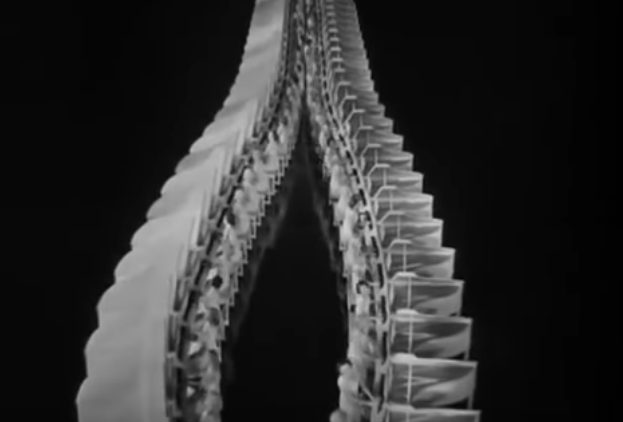
And yet in our modern intellectual discourse Busby has become so hidden, so occluded. The Busbyean spirit has become lost. It has become a slave to the cynical demiurge we naively call “O sweet nostalgia!” or “Those days gone by!” The time has come for all Busbyean partisans to join together and to enact his elaborate jailbreak. Our surrealist champion THE MARVELOUS shall devour that cold Vampire of Nostalgia, that sad pretender to our throne! But how shall we free our dear Busby? Chance-junkies that we all are, we look to the shames of our youth for inspiration, sifting through the trash stratum for an ever-elusive first clue. And it is at the bottom of a dung pile of VHS tape that we find that first flicker of the something-special. A muscular lead actor beckons to us from his cover, eyes owl-wide & body shiny-shirtless. Behind him there is a colorful tableau of exploding red helicopter and seagull. The title reads “THE CHERNOBYL JOB”. We insert our newfound treasure into a beckoning cassette-player hole, and the action feels somehow provocative, obscene. And strangely exciting. We half-expect an ejaculation from somewhere. And we soon get one—of a sort. As we watch this overblown & irrationally plotted Hollywood heist film a sudden spark lights up inside. An escape plan for Busby floats up to the surface of our consciousness, teased out by the absurdity of this film’s screenwriting. Perhaps the trash cinema of the 90’s shall prove useful after all? For in the Land of Psyche it is only the irrational plan, the needlessly labyrinthine plan, the poorly planned plan, that has any chance to succeed. Ah, but to say any more here would surely compromise us—I shall now proceed with a harmless bit of film analysis…
Busby Berkeley’s body of work is musical sigil. And this is a sigil charged by the passage of time. Each day his silver appendages manifest just a tiny bit more inside this layer of our reality. Slowly darkening it, spreading out his occult harmonics…and once that first hundred year cycle reaches its completion…once our centennial unit dissolves into our melodic unit…perhaps then…perhaps…
Busby Berkeley always works ABOVE & BELOW. The abstract geometry of his feminine-divine is soon shifted to the rambling close-ups—humanizing each part of the whole. Our dear Busby is able to dwell in both these realms simultaneously—something those old close-up kings Bergman & Leone have never been able to achieve. They are forever stuck inside the human microcosm. Their wrinkles & squints shall never reach the dizzying heights.
A few thoughts on Gold Diggers of 1933
“We’re in the Money”? That that’s not pig latin after all—for Ginger Rogers is speaking in tongues. Just another common effect of a frequent Busby exposure. Legions of many-limbed golden goddesses invoke the god of prosperity, manifesting an end to the hard times. Few know it today, but Busby Berkeley single handedly ended the depression with the performance of this musical rite.
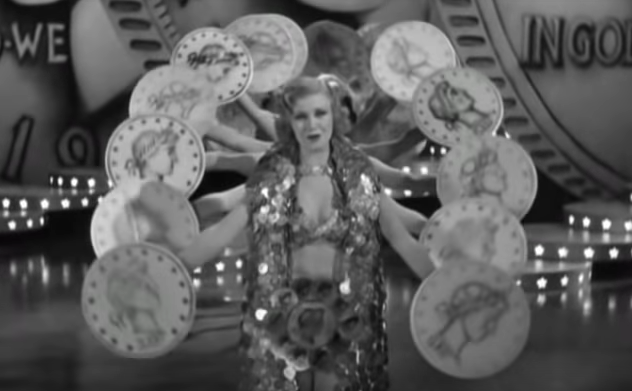
In “Shadow Waltz”, a small white flower becomes a vessel for magical transformation. Flower is mirrored, is turned into spiraling dress-of-white. Flower becomes the dancing Electric Lilith. She sings to us from the shadows, she asks us to “let her dream a song to sing”. She wishes to “bring us the spring”. This archetypal figure is soon mirrored & multiplied inside the dark pool. She descends and ascends the great pyramid simultaneously. For all is simultaneity inside of a Busbyean Zone.
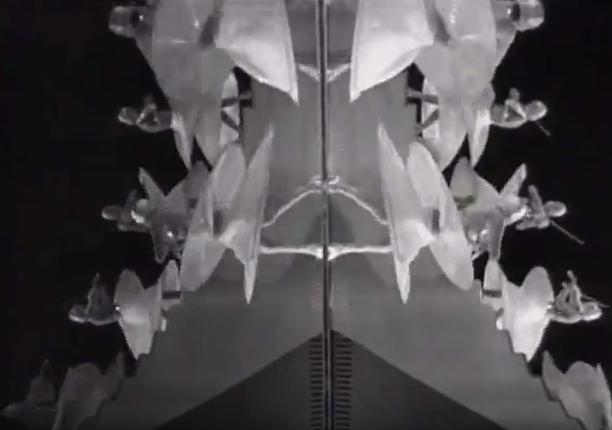
“Pettin’ in the Park”—One of Busby’s more straightforward pieces here, a celebrations of eros and of humor. Here Busby embraces love in all its many forms. The aforementioned “Park Pettin’” is enjoyed by every race, age, and species, it is an extravaganza of pure pure lovin’. Busby’s hatred of authority is also on display as the line of Police piggies are teased by an inexplicable child-thing. This trickster entity seems far too mature and demented for his age, and he also recurs in later Busby films. No doubt this hints to some deeper significance which the creature held inside Busby’s unconscious mind.
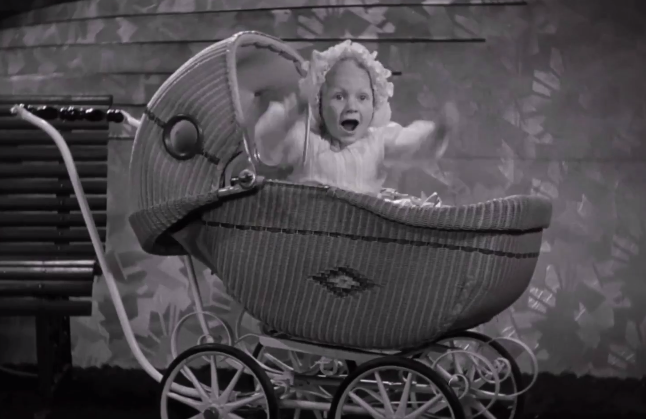
The ending song of Gold Diggers of 1933, “Remember My Forgotten Man”, was Busby’s reaction to some of the trendy new Jungian concepts coming out of Switzerland at the time. The “forgotten man” mentioned in the number symbolizes the repressed shadow self of the unbalanced psyche. We are all urged to remember him—to remember our forgotten shadow selves—or else to face ruin.
A few thoughts on Footlight Parade
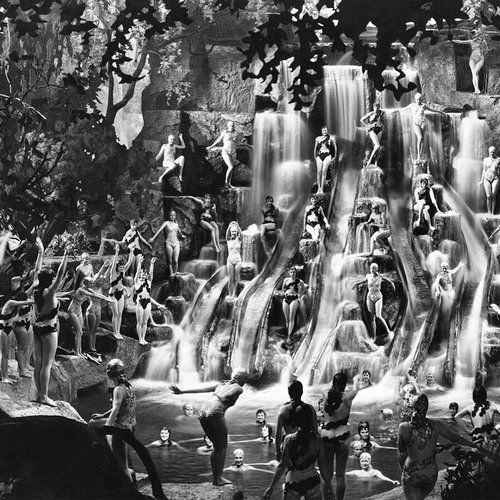
“By a Waterfall” is Busby’s occult masterpiece, the delirious triumph of his Magickal-Musickal art. Busby’s latent pagan agenda is laid bare here for all to see as our dreamy hero sings “there’s a magick melody that mother nature sings to me…” He lays his head down on Ruby Keeler’s lap, and it is there he finds there the wide open door to dreamland. Perhaps the second any man falls asleep all womenkind are mutated into glittering nymphs & fairies? In Busby’s world every women is the fairy queen. Every women is “the whispering waters”. Truly, all the real fun happens when the boys aren’t around. Dick Powell may be an observer of the dream, but Ruby Keeler IS the dream. Like many Busby sequences, this number is also the expansion in time of one very singular & fleeting moment, one tiny drop in the boundless ocean of time. Busby lays the fragile moment under his diabolic movie-ray & the moment inflates wildly. Nietzsche’s eternal return gone kaleidoscopic.
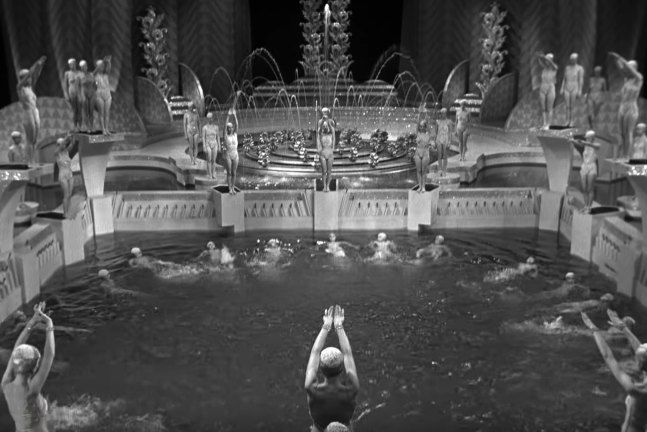
The sequence takes an irrational turn about half-way through. We cut away from the dark & comforting forest, from those nymph-infused waterfalls. Our wide mystic eye beholds the interior of Atlantis—beholds the dream priestess & the hand of Neptune raised in triumph. A Piscean ritual commences, and the three aquatic Ouroboros swallow their own tails. Dark is made Light, and Light Dark. In this Oscillation of Opposites, dissolution. Busby reaches the surrealist “supreme point”. The enchanted swimmers become human become fountain become microbe. All levels existing together in cosmic cohabitation. There is also a sense here that all forms of matter are animated in some way—that even a manmade water fountain has a deep life within. In this scene Busby’s idiosyncratic form of animism is apparent, something which is also later echoed in the sentient women-harps of “Fashions of 1934”.

A few thoughts on Dames
“The Girl With the Ironing Board” is a Busbyean how-to guide on the proper workings of sympathetic magick. Joan Blondell plays a cheeky witch who activates a legion of Undergarment Poppets through the transformative power of Desire. The bodyless poppets sing & cavort, they turn swan and participate in a mass orgy. Soon even the language of the birds is revealed to her.
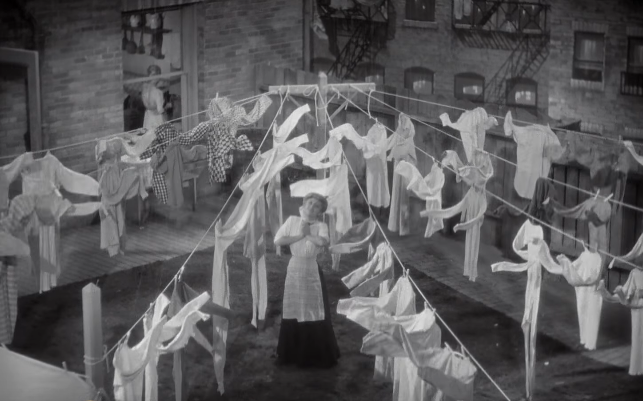
What can even be said about the infamous “Dames” sequence that hasn’t been said a million times before? But I will say one thing. It is the drop of black blood which activates the female pentagram. It is the drop of black blood which opens the door. Kali is ever present here. And only the whims of your pareidolia can tell you what dark face lies within that shifting wall of feminine…

A few thoughts on Gold Diggers of 1935
With “The Words Are in My Heart” we come again to the old enchantment of the night. The scene starts with two uncertain lovers on a theatrical stage. The stage on which our actors exist is soon transformed into a miniaturist’s set which is sitting on the top of giant piano.The piano is played by three mysterious women that we do not know. Three witches? Three Fates? Our camera-eye then shifts inside the belly of the piano which they play, miniaturizing us. (A full 42 years before David Lynch’s “Lady in the Radiator” even existed!) We see hundreds of dancing piano-people swarming the inside of a dark cathedral. It’s Piano all the way down it seems, it’s Piano made fractal. Their blank happy faces give us the feeling that some kind of devilry is afoot here, some kind of musical bewitching. A ghost women dances in reverse while the piano-continents form, and the inner egg is fertilized by the musical sperm. We then zoom out from the belly of the piano, back to the scale of the giantess. The dream clock strikes twelve. The three fates blow out three candles, and our camera-eye is suddenly back down on that stage, the place where we had started this journey…

The most exceptional feature of this sequence is its constant disorientation of all spatial boundaries and its mixing of interior and the exterior worlds. Are these characters inside this world—or is the world inside of them? What is up, what is down? This sequence is like a child who lays down in the warm green grass to stare at the drama of an ant. It is a journey back to the forgotten mental spaces of our childhood, to that innocent madness. It also speaks to the eternal inadequacy of all linguistic expression. Our lead actor sings that he cannot find the proper words to express his love, that all the conventional symbols available cannot match up with the true word, that word that is written in his heart. He says “even though I can’t say it”—and yet, he must still use a language in order to say that he can’t say it, the poor sap. But the musical dream which follows shows us the true face of those “words in his heart”. The inexpressible is made manifest. Perhaps it is only through surrealism that we can reach those “true words”.
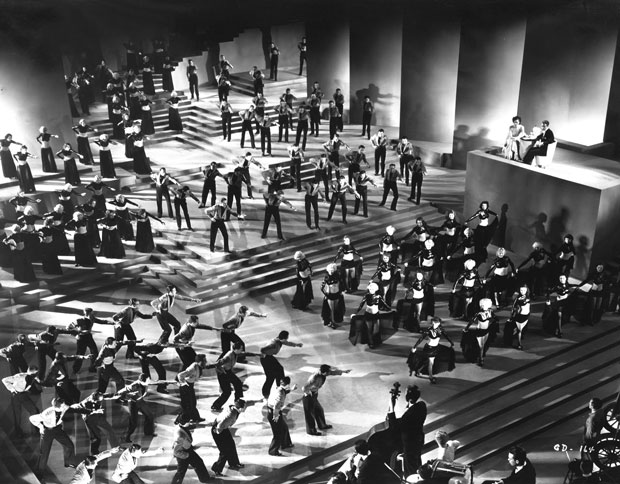
“Lullaby of Broadway” is Busby’s darkest moment. Here the dream is turned nightmare. Why did Busby choose to end this otherwise happy film in such a peculiar way? No one really knows, though many have speculated. A mental break? A lost love? The tabloids all ran wild in those days… A mysterious dream demon called “The Milkman” hovers over the entire musical proceedings, and we are often warned “Milkman’s on his way!” Aggressive figures tap-dance across a cold De Chirico space, yelling “COME AND DANCE”. And these words are command, not invitation. The tap-dancing automatons have been possessed by a god, they have become dance-mad. One must be wary of any dance which possesses its own Will. At the end of the dream the lead actress is murdered, forced from the balcony by the dancers. And we are shown another riddle still—-this women’s body has also vanished from her waking life. Because for Busby there was never any real difference. Still, we are left to wonder—who is that shadowy Milkman? Who is he that haunts at the Edge of Dream? We can only guess at what he had symbolized for Busby—was he the Devil, or Death himself? Or perhaps the Milkman was a sign of the things to come for poor Busby? A prophecy drawn from unconscious depths, and yet left unheeded? Just few months later—and the fatal car crash occurs. Two bodies are dead and mangled, and a second degree murder charge is hanging over his head. And then the fading film career, the alcoholism, the dead mother. The failed suicide attempt. At the very end of this foreboding musical number a singer’s disembodied face is seen slowly receding into the night, the inky blackness expanding around her until she has become nothing. Song has returned to the primordial darkness.
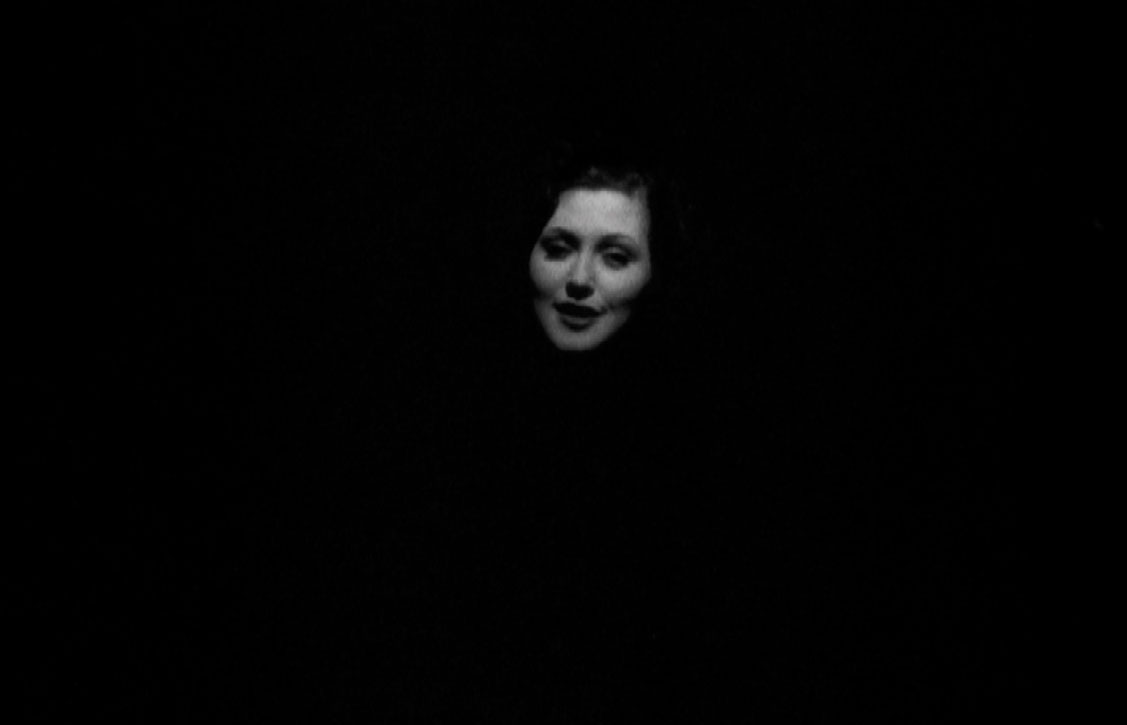
In Conclusion?
All Busby Berkeley musical numbers are a secret magickal working.
For on the tail of the serpent of time is written his vibration and his rhythm.
For on the tail of the serpent of time is written the golden initials—“BB”.
This has been long concealed yet eternally open.
For Dance is a deepdive into Marvelous.
& Song is the twin sister to Dance.
Added together they may form Trance.
But multiplied they equal Radiant.
– SC

